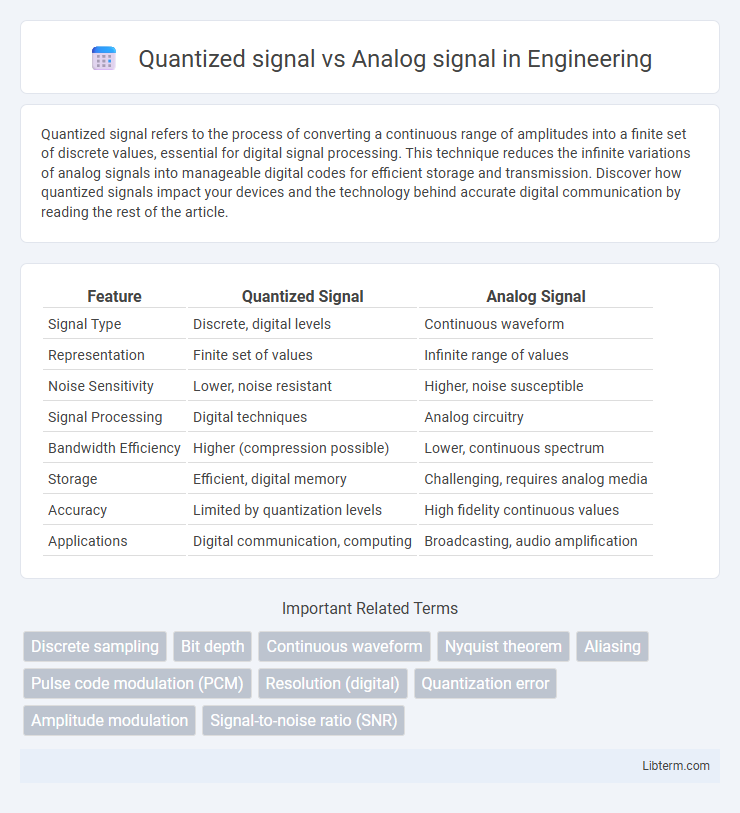Quantized signal refers to the process of converting a continuous range of amplitudes into a finite set of discrete values, essential for digital signal processing. This technique reduces the infinite variations of analog signals into manageable digital codes for efficient storage and transmission. Discover how quantized signals impact your devices and the technology behind accurate digital communication by reading the rest of the article.
Table of Comparison
| Feature | Quantized Signal | Analog Signal |
|---|---|---|
| Signal Type | Discrete, digital levels | Continuous waveform |
| Representation | Finite set of values | Infinite range of values |
| Noise Sensitivity | Lower, noise resistant | Higher, noise susceptible |
| Signal Processing | Digital techniques | Analog circuitry |
| Bandwidth Efficiency | Higher (compression possible) | Lower, continuous spectrum |
| Storage | Efficient, digital memory | Challenging, requires analog media |
| Accuracy | Limited by quantization levels | High fidelity continuous values |
| Applications | Digital communication, computing | Broadcasting, audio amplification |
Introduction to Quantized and Analog Signals
Quantized signals represent discrete digital values obtained by sampling and rounding continuous analog signals, enabling efficient data storage and processing in digital systems. Analog signals vary continuously over time, capturing real-world phenomena such as sound, light, and temperature with infinite resolution. The fundamental difference lies in quantization, where analog signals undergo conversion to finite discrete levels, facilitating digital communication and computation.
Fundamental Differences Between Quantized and Analog Signals
Quantized signals consist of discrete amplitude levels, representing continuous analog signals through a finite set of values, which introduces quantization error. Analog signals vary smoothly and continuously over time, capturing an infinite range of possible amplitudes without digital approximation. The fundamental difference lies in quantized signals being digitally encoded for processing and storage, whereas analog signals remain in their natural, continuous form suitable for real-time reproduction.
How Analog Signals Work
Analog signals function by continuously varying their amplitude or frequency to represent information, allowing for a smooth and infinite range of values over time. These signals are typically generated by natural phenomena or physical sensors that convert real-world inputs, such as sound or temperature, into corresponding electrical waveforms. Because of their continuous nature, analog signals can capture subtle nuances in data, but are more susceptible to noise and distortion compared to quantized, digital signals.
Understanding Quantized Signals
Quantized signals convert continuous analog signals into discrete levels, enabling efficient digital representation and processing. This process involves sampling the analog waveform at uniform intervals and assigning each sample a finite set of values, which reduces precision but facilitates error detection and data compression. Understanding quantized signals is crucial in digital communication systems where bandwidth limitations and noise resilience are optimized through controlled quantization levels.
Key Characteristics of Analog Signals
Analog signals are continuous waveforms that vary smoothly over time, representing information through changes in amplitude, frequency, or phase. They possess infinite resolution within their range, allowing for detailed signal variations but are more susceptible to noise and distortion during transmission. Key characteristics include their continuous nature, infinite precision, and vulnerability to signal degradation.
Key Characteristics of Quantized Signals
Quantized signals consist of discrete amplitude levels representing continuous analog signals, enabling efficient digital processing and storage. Key characteristics include finite resolution determined by the number of quantization levels, quantization noise caused by rounding errors, and reduced signal bandwidth compared to the original analog waveform. These features make quantized signals essential for digital communication systems and audio-visual technologies.
Advantages and Disadvantages of Analog Signals
Analog signals provide continuous data representation, offering higher resolution and natural waveform reproduction, which is beneficial in audio and video transmissions. However, they are more susceptible to noise and signal degradation over long distances, leading to quality loss and distortion. The lack of efficient compression makes analog signals less suitable for modern digital communication systems compared to quantized signals.
Benefits and Limitations of Quantized Signals
Quantized signals enable efficient digital processing and storage by converting continuous analog signals into discrete levels, reducing noise susceptibility and facilitating error detection. However, quantization introduces quantization error and limited resolution, which can cause signal distortion and loss of detail compared to analog signals. Despite these limitations, quantized signals are essential in modern communication systems for reliable data transmission and compatibility with digital devices.
Real-World Applications of Quantized vs Analog Signals
Quantized signals are essential in digital communication systems, enabling efficient data compression and error detection in applications such as mobile phones and digital audio players. Analog signals are predominantly used in traditional broadcasting and sensor systems where continuous signal representation preserves subtle variations, such as in analog microphones and temperature sensors. The choice between quantized and analog signals depends on the trade-off between signal accuracy and ease of processing in real-world scenarios.
Future Trends in Signal Processing
Future trends in signal processing emphasize the shift from analog signals to quantized signals due to advancements in digital technology and machine learning integration. Quantized signals enable improved noise resistance, data compression efficiency, and compatibility with AI-driven analytics, making them essential for next-generation communication systems and IoT devices. Emerging applications in 5G/6G networks and edge computing rely heavily on precise quantization techniques to optimize bandwidth and real-time processing capabilities.
Quantized signal Infographic

 libterm.com
libterm.com